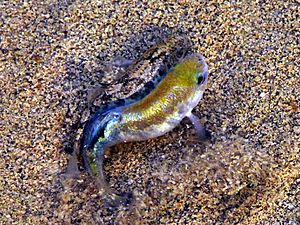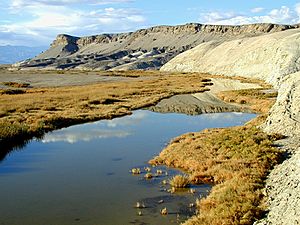Death Valley pupfish facts for kids
Quick facts for kids Death Valley Pupfish |
|
|---|---|
 |
|
| Male (right) and female (left) | |
| Conservation status | |
| Scientific classification | |
| Subspecies | |
|
The Death Valley pupfish is a tiny fish that lives only in Death Valley National Park in California, USA. It's also called the Salt Creek pupfish. This special fish belongs to the family Cyprinodontidae.
There are two types, or subspecies, of the Death Valley pupfish. They are called C. s. salinus and C. s. milleri. These fish are very rare. They live in only two small, separate places. Because of this, the Death Valley pupfish is currently listed as an endangered species. This means it is at risk of disappearing forever.
What is a Pupfish?
The desert pupfish is a small, shiny silver fish. It has 6 to 9 dark stripes along its sides. Most pupfish are about 3.7 cm (1.5 in) long. The longest one ever found was 7.8 cm (3.1 in) long.
During their mating season, from April to October, the male pupfish turn a bright blue color. These fish are incredibly tough! They can survive in very harsh conditions that would kill most other fish. For example, they can live in water that is four times saltier than the ocean. They can also handle very hot water, up to 116 °F (47 °C), and very cold water, down to 32 °F (0 °C).
Where Do Pupfish Live?
This amazing fish is found in only two spots within Death Valley. One type, the salinus subspecies, lives in Salt Creek. This area is about 49 m (161 ft) below sea level. The other type, the milleri subspecies, lives in Cottonball Marsh. This marsh is even lower, at about 80 m (260 ft) below sea level.
Scientists believe these pupfish are what's left of a much larger group of fish. These fish lived in a huge ancient lake called Lake Manly. This lake dried up when the last ice age ended. It left behind the Death Valley we know today. The Salt Creek pupfish can also be found in River Springs and Soda Lake, both within Death Valley National Park.
Protecting the Pupfish
The IUCN has listed the desert pupfish as an endangered species. This is because it lives in such a tiny area. If both locations were counted as one, it would be considered critically endangered. This means it's in even greater danger.
The number of pupfish changes a lot throughout the year. It depends on how much water is in their habitat. Even though their entire home is in a protected park, the pupfish still face threats. These include:
- New types of fish accidentally brought into their habitat.
- Natural disasters that could harm their small homes.
- Too much water being pumped from the underground water source, called an aquifer, that feeds their homes.
Protecting these unique fish helps keep the amazing wildlife of Death Valley safe.



